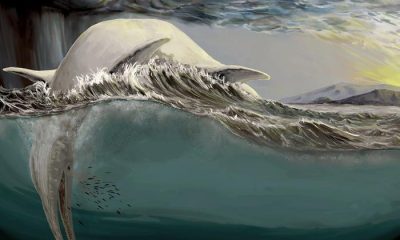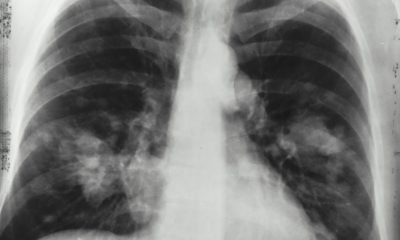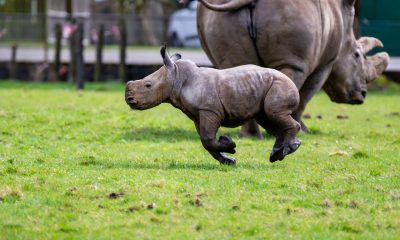Scientists reveal reason T. Rex had such short arms
A 45-foot-long T. Rex had arms only three feet long
Published
2 years ago onBy
Talker News
By Jim Leffman via SWNS
The reason iconic dinosaur Tyrannosaurus Rex has such short arms was to stop them from getting deadly injuries during feeding frenzies on carcasses, scientists believe.
The latest theory is that the predator's arms shrank to their tiny size to prevent accidental or intentional amputation when a pack of T. Rexes descended on prey with their massive heads and bone-crushing teeth.
A 45-foot-long T. Rex might have had a five-foot-long skull, but arms only three feet long, the equivalent of a six-foot human with five-inch arms.
Paleontologist Kevin Padian, Professor of Integrative Biology at the University of California, Berkeley, has been pondering the question or decades.
Other theories include for mating, for holding or stabbing prey or even tipping over a Triceratops.
Prof Padian said: "Rather than asking what the T. Rex’s short arms evolved to do, the question should be what benefit those arms were for the whole animal.
“What if several adult tyrannosaurs converged on a carcass? You have a bunch of massive skulls, with incredibly powerful jaws and teeth, ripping and chomping down flesh and bone right next to you.
"What if your friend there thinks you’re getting a little too close? They might warn you away by severing your arm.
"So, it could be a benefit to reduce the forelimbs, since you’re not using them in predation anyway.
"Severe bite wounds can cause infection, hemorrhaging, shock and eventual death."
Prof Padian, also a curator at the UC Museum of Paleontology, said that T.rex's ancestors, some of which were even bigger than T. Rex, had long arms so there must have been a reason that they became reduced in both size and joint mobility.
He added: "All of the ideas that have been put forward about this are either untested or impossible because they can't work.
"And none of the hypotheses explain why the arms would get smaller. The best they could do is explain why they would maintain the small size.
"And in every case, all of the proposed functions would have been much more effective if the arms had not been reduced."
The study, published in the journal Acta Palaeontologia Polonica, admits that the theory will be hard to substantiate.
When the great dinosaur hunter Barnum Brown discovered the first T. Rex fossils in 1900, he thought the arms were too small to be part of the skeleton.
His colleague, Henry Fairfield Osborn, who described and named T. Rex, hypothesized that the short arms might have been “pectoral claspers” — limbs that hold the female in place during copulation.
This is similar to some sharks and rays’ pelvic claspers, which are modified fins, but Osborn provided no evidence.
Prof Padian said that T. Rex’s arms are too short to go around another T. Rex and certainly too weak to exert any control over a mate.
Other proposed explanations for the short arms included waving for mate attraction or social signaling, serving as an anchor to allow T. Rex to get up from the ground, holding down prey, stabbing enemies, and even pushing over a sleeping Triceratops at night.
Some palaeontologists even propose that the arms had no function at all, so we shouldn’t be concerned with them.
Prof Padian said: “The arms are simply too short,.
"They can’t touch each other, they can’t reach the mouth, and their mobility is so limited that they can’t stretch very far, either forward or upward.
"The enormous head and neck are way out in front of them and pretty much form the kind of death machine you saw in Jurassic Park."
The answer came to Prof Padian after other paleontologists unearthed evidence that some tyrannosaurids hunted in packs, not singly, as often depicted.
He said: “Several important quarry sites unearthed in the past 20 years preserve adult and juvenile tyrannosaurs together.
"We can’t really assume that they lived together or even died together. We only know that they were buried together.
"But when you find several sites with the same animals, that’s a stronger signal. And the possibility, which other researchers have already raised, is that they were hunting in groups.”
Perhaps, he thought, the arms shrank to get out of the way during pack feeding. T. Rex youngsters, in particular, would have been wise to wait until the larger adults were finished.
Twenty years ago, two palaeontologists analysed the arms and hypothesised that T. Rex could have bench pressed about 400 pounds with its arms.
Prof Padian added: "But the thing is, it can't get close enough to anything to pick it up."
Although not conclusive, crocodiles and Komodo dragons descend in packs, leaving the smaller bits for their young when they have finished but often suffering maulings.
Prof Padian said: “Bite wounds on the skull and other parts of the skeleton are well known in tyrannosaurs and other carnivorous dinosaurs.
"If fewer bite marks were found on the reduced limbs, it could be a sign that reduction worked.
"To me, this study of what the arms did is interesting because of how we tell stories in science and what qualifies as an explanation.
"We tell a lot of stories like this about possible functions of T. Rex because it's an interesting problem. But are we really looking at the problem the right way?"
Stories and infographics by ‘Talker Research’ are available to download & ready to use. Stories and videos by ‘Talker News’ are managed by SWNS. To license content for editorial or commercial use and to see the full scope of SWNS content, please email [email protected] or submit an inquiry via our contact form.
You may like


This type of exercise can help reduce anxiety and depression


Study suggests evening exercise best for obese people


Galactic Goliath! Black hole 33 times Sun’s mass discovered nearby


Scientists solve mystery of which giant roamed these British waters


Sudden surge in lung cancer cases in non-smokers may be due to this


Warming ocean currents threaten Antarctic ice
Other Stories


Pro mermaid’s career goes swimmingly after overcoming ocean fear
She makes up to $8,000 a show.


Giant prehistoric salmon used tusk-like teeth to fight off predators
The species that grew up to nine feet long lived in the North American Pacific Northwest.


Evidence of Earth’s magnetic field dates back 3.7 billion years
Life on Earth would not be possible without its magnetic field.


Adorable video shows baby rhino enjoying sunshine
By Faye Mayern via SWNS An endangered baby rhino has well and truly found its feet after being filmed playing...


Hilarious moment delivery man gets chased by tiny dog
The hilarious encounter was caught on video.
Top Talkers

 Parenting7 days ago
Parenting7 days agoSingle mom details struggles of feeding her 12 kids

 Lifestyle6 days ago
Lifestyle6 days agoWoman regrets her tattoo nightmare: ‘It’s horrendous’

 Good News2 days ago
Good News2 days agoDisabled student takes first steps in 10 years on graduation stage

 Broadcast1 week ago
Broadcast1 week agoOver 40% of Americans have no clue what a 401k is

 Health3 days ago
Health3 days agoNew study reveals ‘old age’ begins later than it used to

 Broadcast1 week ago
Broadcast1 week agoHow hard is it for Americans to live sustainably?

 Money1 week ago
Money1 week agoOver 40% of Americans have no clue what a 401k is

 Wildlife2 days ago
Wildlife2 days agoClever elephant returns visitor’s shoe after falling into enclosure
